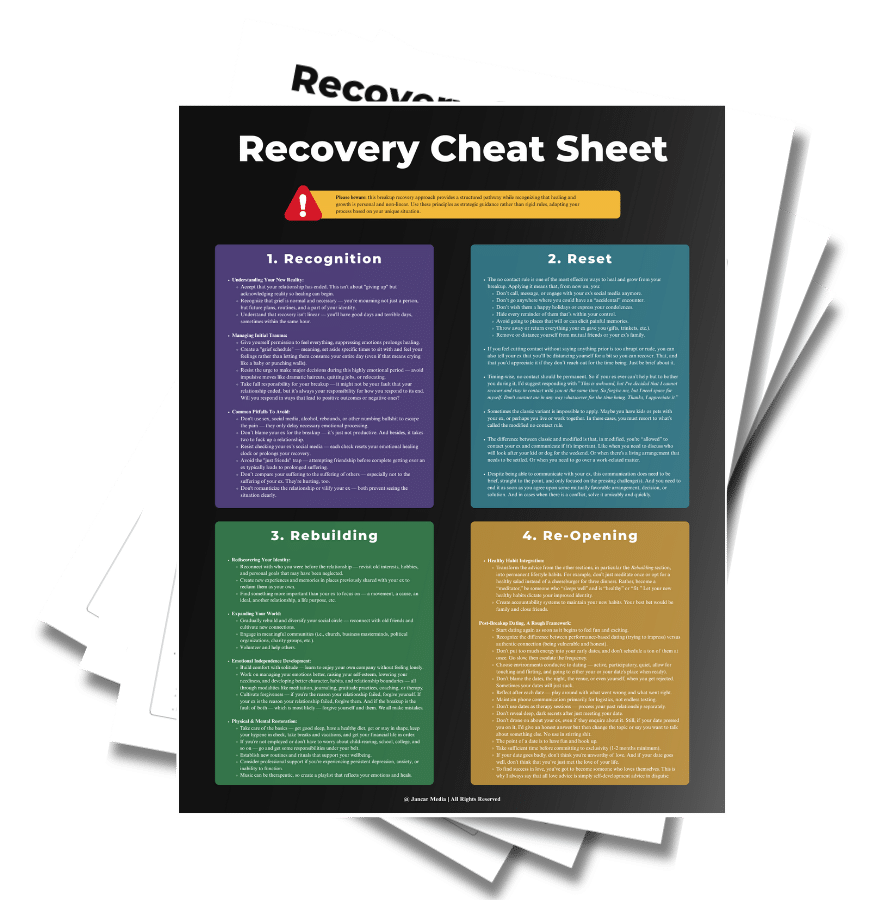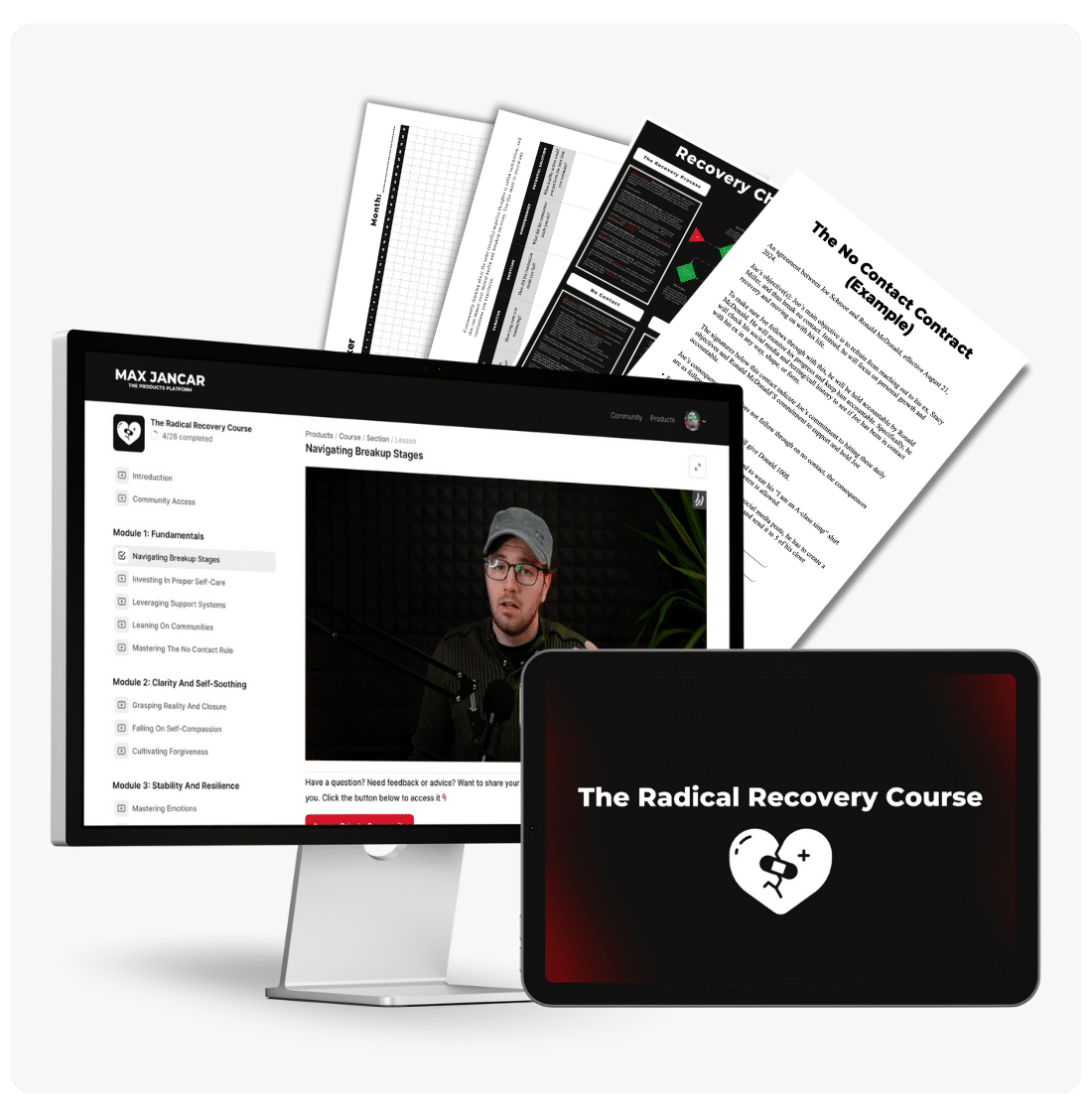Click play to listen to this article.
Developed by John Bowlby and Mary Ainsworth, attachment theory is not only a solid explanation for why your relationship failed — it’s also the solution for most, if not all, of your relational struggles.
It essentially talks about how our primary attachment bond — the bond we cultivate during early childhood by how we interact with our parents — represents a model for our future relationships and how, out of that primary attachment, we develop one of four attachment styles: anxious, avoidant, anxious-avoidant, or secure.
Once developed, these styles dramatically influence our mental health, self-esteem, the partners we choose, how our relationships pan out, and how we respond when they end. (1)
A guide to breakup recovery based on embracing discomfort, extracting wisdom from dark moments, and healing through evidence-based practices.
Order Your CopyAttachment Styles And Relationship Patterns
As I alluded to earlier, our attachment styles begin to develop in childhood. As a kid grows up, they want to explore the world around them. But the world can be dangerous. The chair they climb on can fall. The shiny kitchen stove can burn them. The little dog by the sidewalk may bite their hand off. Everything children learn, each step of the way, is through trial and error.
In other words, young children often fall into a behavioral pattern of some sort. In most cases, they seek security and comfort from their parents. Yet sometimes, they want to go and leave them behind and explore the occasionally dangerous world. And sometimes, while exploring, it becomes really painful or scary, and suddenly, they bolt back to their parents.
This dance between security/comfort and insecurity/exploration continues and expands as the child grows up. Young infants need the security of their caretakers more or less all the time, with only brief flickers of self-assured exploration. Older kids need a good amount of both. By the time you get to teenagers, it’s almost all exploration, all the time.
So in a way, parenting comes down to two skills: a) letting your kids roam and explore when they need to, and b) providing that safety and comfort when they need you. Parents who nail this balance will generally raise emotionally stable and healthy kids who go on to have healthy and stable romantic relationships later in life.
If you’re reading this, that’s probably not you. But that’s fine, it wasn’t me either.
The Anxious Attachment Style
If parents have two primary jobs, then there are two ways they can screw it up. One way is when a parent doesn’t allow their children to explore freely enough or coddles them way too much. These children often never fully develop a sense of independence. They grow up feeling as though they always need someone with them in order to feel comfortable and confident. And so, they become a likely host for the anxious attachment style.
In romantic relationships, anxiously attached individuals are typically people pleasers who think of themselves as lesser than the person they love. They’re also needy, sporadic, neurotic, and need tons of attention and affection all the damn time. Not to mention approval, validation, and reassurance that they’re still loved, worthy, and cared for.
These people have trouble being alone or single and often rely on their romantic interest for their daily dose of happiness because they can’t make themselves happy. They also become emotionally attached to others rapidly and very strongly — so strongly, in fact, that they often scare away the people they want in their lives.
To give some examples of anxious attachment.
- This is someone who would spam their partner’s phone, try to control what they’re doing or where they’re going, and desperately chase after them.
- This is someone who believes they need to earn sex/love and thus becomes needy and constantly proves themselves that they are worthy of sex/love.
- This is someone who tries to game and manipulate their date so they stick around.
When it comes to their response to breakups, anxious individuals feel most distraught out of all the attachment styles and are most prone to becoming depressed. You often see them either going on a dating rampage in hopes of finding someone new to attach to, or trying to desperately get their ex back — and failing miserably at it. (2)
The Avoidant Attachment Style
If parents screw up the other way, that is, they provide a child plenty of freedom to explore but are unreliable at being present and offering safety and comfort when the child needs it, the kid develops a firm and cold independence and grows mistrustful of others. And so, they become a likely host for the avoidant attachment style.
In romantic relationships, such a person often feels “crowded,” “smothered,” or “uncomfortable” by even the most basic displays of affection and intimacy. They have a difficult time trusting their partner, seek isolation, and suppress their emotions. (3)
Avoidants also alienate the people they want in their lives simply because they irrationally feel that their independence is being threatened at every turn. At worst, they construct their entire lifestyle in such a way as to avoid commitment or too much intimate contact altogether. An exemplary demographic here is digital nomads (laughs nervously…).
To give some examples of avoidant attachment.
- This is someone who goes on a few dates with a person but then gets scared, anxious, and smothered when they open up or when they start developing intimacy with them.
- This is someone who dates their partner regularly but avoids getting physical and intimate with them because they feel shame around their sexuality or have a lot of anxiety about their ability to perform in bed.
- This is someone who starts feeling unattracted to anyone who treats them with respect and admiration because they don’t feel worthy of it.
When it comes to how avoidants respond to breakups they usually act as if they’re not affected by it, and only repress their pain and negative feelings. As a result, however, they usually develop some form of trauma and limiting beliefs, and they subject themselves to random spurts of intense emotion or tamper tantrums. Mainly because every feeling needs an outlet of some sort.
The Anxious-Avoidant Attachment Style
If parents completely failed at both their jobs — to remind you: they failed to show comfort/support and they failed to give their child the freedom to explore — then this child might end up with what’s called an anxious-avoidant attachment style.
These people have the worst of both worlds: they desperately crave attention and affection at all times, yet trust no one, and feel intense anxiety around everyone.
A few examples of anxious avoidance:
- This is someone who wants to get emotionally close to their partner but worries about them hurting their feelings.
- This is someone who wants to feel close to their partner but also can’t trust them enough to want to be close to them.
- This is someone who can’t live without their partner, even though their relationship is clearly not working.
The Secure Attachment Style
Finally, if a child had grown up with parents who nailed both of their jobs — to remind you, these are letting them roam and explore while providing safety and comfort when the child needed it — this child likely grew up with a secure attachment style.
In romantic relationships, people with a secure attachment style are generally comfortable displaying interest and affection. They are also comfortable being alone and independent. They can correctly prioritize their relationships within their life and tend to draw clear boundaries and stick to them.
Secure attachment types obviously make the best romantic partners, family members, and even friends. They’re capable of accepting rejection and moving on despite the pain but can also be loyal and sacrifice their wants when necessary. They have few issues trusting people they’re close to and are trustworthy themselves.
Ultimately, secure is what you want to be in order to have healthy relationships, be that with your ex, or with just about anyone you get romantically involved with.
Other Influences On Attachment Styles
Apart from parenting, there are three other major influences on our attachment style — genetics, peer groups, and previous romantic relationships. Let’s go over each one.
Genetics
While genetics don’t determine everything, they are important. For example, if a person is fiercely independent and refuses to be held down by commitments — they’re leaning towards avoidance — then this person is likely genetically wired to be this way to a degree. Same story for a person who always wants to be the center of attention — they’re probably programmed to lean towards these anxious tendencies.
The annoying thing about genetics is that we can’t really change them. We can only accept them, whether good or bad. In other words, we’re not to blame for our genetics, but it is our responsibility to do the best with what we’ve been given. Likewise, we need to set proper expectations based on our genetic makeup.
If you’re someone highly social who has a string of highly social siblings and ancestors, you’ve got to accept that you’ll never be a hardcore independent and introverted person. Similarly, if you’re highly independent and introverted, you must accept that you’ll never be a natural social butterfly — and that’s fine.
Peer Groups
With the base for your attachment style laid out by your parents (both in terms of genetics and their parenting capacity), you eventually get to a point where you’re not as close to them any longer. This is when peer groups — that is, friends and classmates — will start having a big effect on your personality and emotional stability, hence on your attachment style.
If you grew up in an environment where making friends was a pain in the ass, then you probably developed many avoidant attachment tendencies, which usually lead to avoidant attachment.
But if you grew up in an environment where everyone was safe and connected — perhaps one where everyone also looked, dressed, and acted the same way — you likely developed many anxious attachment tendencies, which usually lead to anxious attachment.
Previous Romantic Relationships
Interestingly, we can apply the same principle of security/comfort and insecurity/exploration to our previous romantic relationships, be that casual or committed ones.
So if you were in a relationship with a highly controlling and overbearing partner for an extended period, that may exacerbate your insecurity and attachment issues. It could also prompt you to become wildly self-sufficient and cautious when you decide to date someone new later on — that is, it could prompt you to develop an avoidant attachment style.
In a similar vein, spending many years in a relationship with an absent partner who frequently distances themselves from you, or who is never reliable, may cause you to develop an anxious attachment style.
An online interactive video course that teaches you how to get past a breakup so you can create a new possibility for love (with your ex or someone new).
Get Instant AccessToxic Dynamics Between Attachment Styles
Here’s a nasty thing about attachments. The insecurely attached, like the anxious, avoidant, anxious-avoidant — they often end up dating one another, creating a dumpster fire of a relationship.
The (generally more) anxious person is drawn to the (generally more) avoidant because when they withdraw, they trigger their fear of abandonment, creating a cycle of seeking reassurance and validation.
This dynamic initially fulfills their attachment needs, as the anxious feels temporarily soothed when the avoidant momentarily engages in closeness. But sooner or later, the avoidant withdraws, intensifying the anxious person’s need for closeness. Then the chaser-chasee cycle begins — one person keeps pursuing closeness and intimacy, while the other keeps running away from closeness and intimacy.
And it’s this cycle, while it feels exciting at times, that only creates emotional instability and insecurity within the relationship. The anxious person constantly feels neglected and rejected, while the avoidant constantly feels suffocated and overwhelmed.
Eventually, the toxicity becomes unbearable, and the relationship ends in a breakup. Or, worse, the two incompatible idiots stay together, perpetually marinating in resentment, drama, and misery.
How To Change Your Attachment Style
Before you change it, it’s worth figuring out what attachment style you harbor in the first place. To pinpoint it, either go to a therapist and ask them if they can identify it for you or take one of many online self-identification quizzes.
Simply type “Attachment Style Quiz” into Google to find one. These quizzes usually take about 5 to 10 minutes to complete. Just be sure not to take them too seriously; they’re not as accurate as people often promote them to be.
Also, note that secure individuals can have both anxious or avoidant tendencies. So you can be fundamentally secure but still, for instance, avoid commitment or intimacy sometimes or occasionally worry about whether you’re lovable or not.
This is normal. Because, like with most emotional problems, while you can always learn to manage your attachment issues better, you’ll never eliminate all of them.
To transition into changing your attachment style for the better, the first thing to know is that it’s difficult as fuck. For perspective’s sake, it took me two years of therapy and three years of dating secure people and going over self-help material to get to a secure attachment style. That said, here are a few pointers I saw working time and time again for most people.
Going From Anxious To Secure
- Find what triggers your anxiety and become aware of when you’re feeling it. The idea is that once you figure out what triggers your anxiety, you can find ways to eliminate those triggers. And when you become aware of your anxiety, you can manage it better. (4)
- Leverage proven healing modalities. To name a few: meditation, journaling, yoga, qi-gong, dream reporting, self-love practices, gratitude practices. (5)
- Look for overreactions to certain situations. Then try to see them for what they are: overreactions. A good way to make this a daily habit is to consistently, when anxious, ask yourself, “Is it reasonable to feel so anxious, or is my attachment playing tricks on me?”
- Date someone with a secure attachment style. This will allow you to absorb some of their security and grow more secure yourself.
Going From Avoidant To Secure
- Practice vulnerability. Get used to repeatedly opening up about the views and beliefs you’re most afraid to express. For example, when you meet up with a good friend, after a few minutes of banter, share some of your deeper, more personal thoughts and opinions with them — something you haven’t shared before. Something uncomfortable.
- Practice self-awareness. Try to notice your avoidant tendencies in your interactions. And instead of closing off when they happen, make a conscious choice to open up even more. Asking yourself the following may also help, “Do I feel alarmed for a good reason, or are my avoidant tendencies getting the best of me?”
- Date someone with a secure attachment style. Same as I wrote above. This will allow you to absorb some of their security and grow more secure yourself.
Going From Anxious-Avoidant To Secure
- Practice all of the above — vulnerability, awareness, self-examination, healing modalities, dating someone secure.
- Seek out a therapist. Anxious avoidance is the rarest and most complicated attachment type, and an average person won’t be able to change it alone. Most often, professional intervention is required. Note that you might need to hop around several therapists before you find someone you can relate with and who you can trust — this is normal. Persist with it and when you find someone who suits you, stick with them for the long term otherwise it won’t work.
We All Lose Control Of Our Attachment Car Sometimes
Regardless of your attachment style, the road to changing it is filled with obstacles. And you will inevitably bump and crash into some of them.
Sometimes anxious attachment types will reach out to their ex even though they know they shouldn’t. Other times, avoidants will go on a bed-crushing, cum-on-the-wall rampage with total strangers, only to push their hurt deeper into their unconscious. It’s okay.
People lose control of their Attachment Car all the time. When it happens to you, don’t beat yourself up about it. When you bump into your next obstacle, just put the bitch in reverse, adjust course, center grill, then slam the living shit out of that gas pedal.
Then repeat the process at the next obstacle. And the next. And the next… all up until you reach your destination — the secure attachment.
This cheat sheet lays out 40+ solutions to overcoming a breakup so you can create a new opportunity for love — be that with your ex or someone completely different.
Get The Free Cheat Sheet


